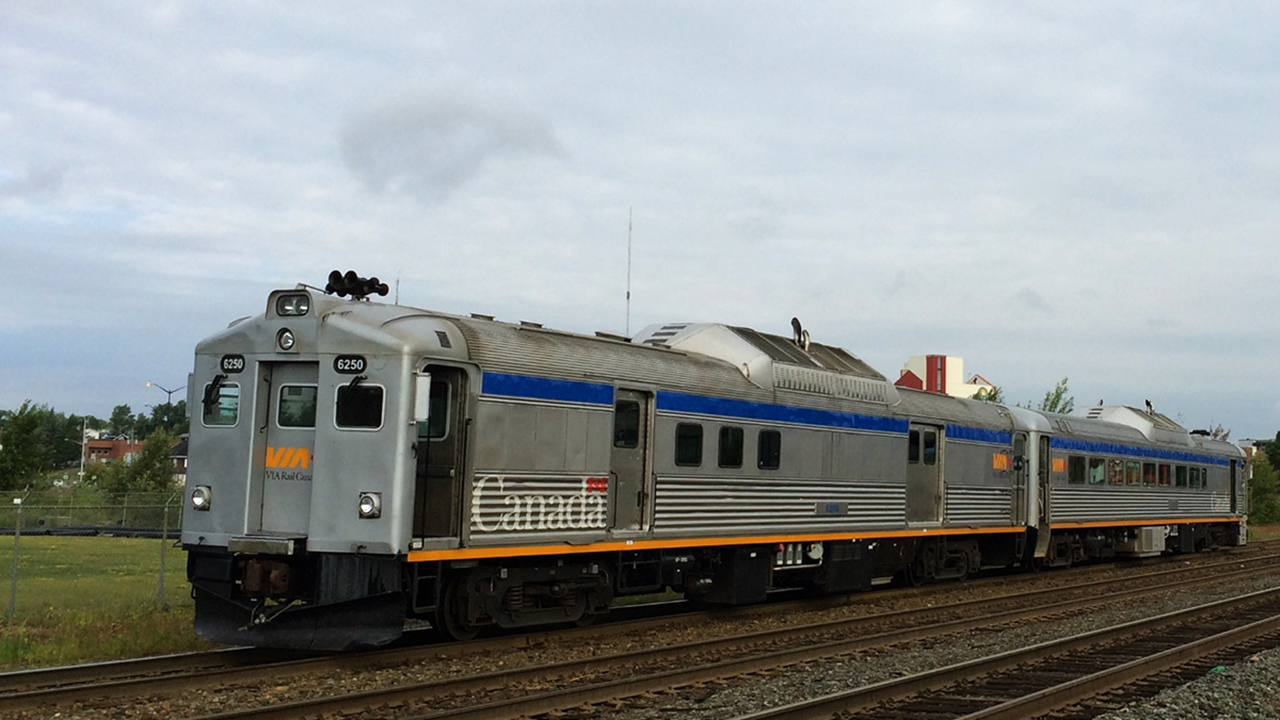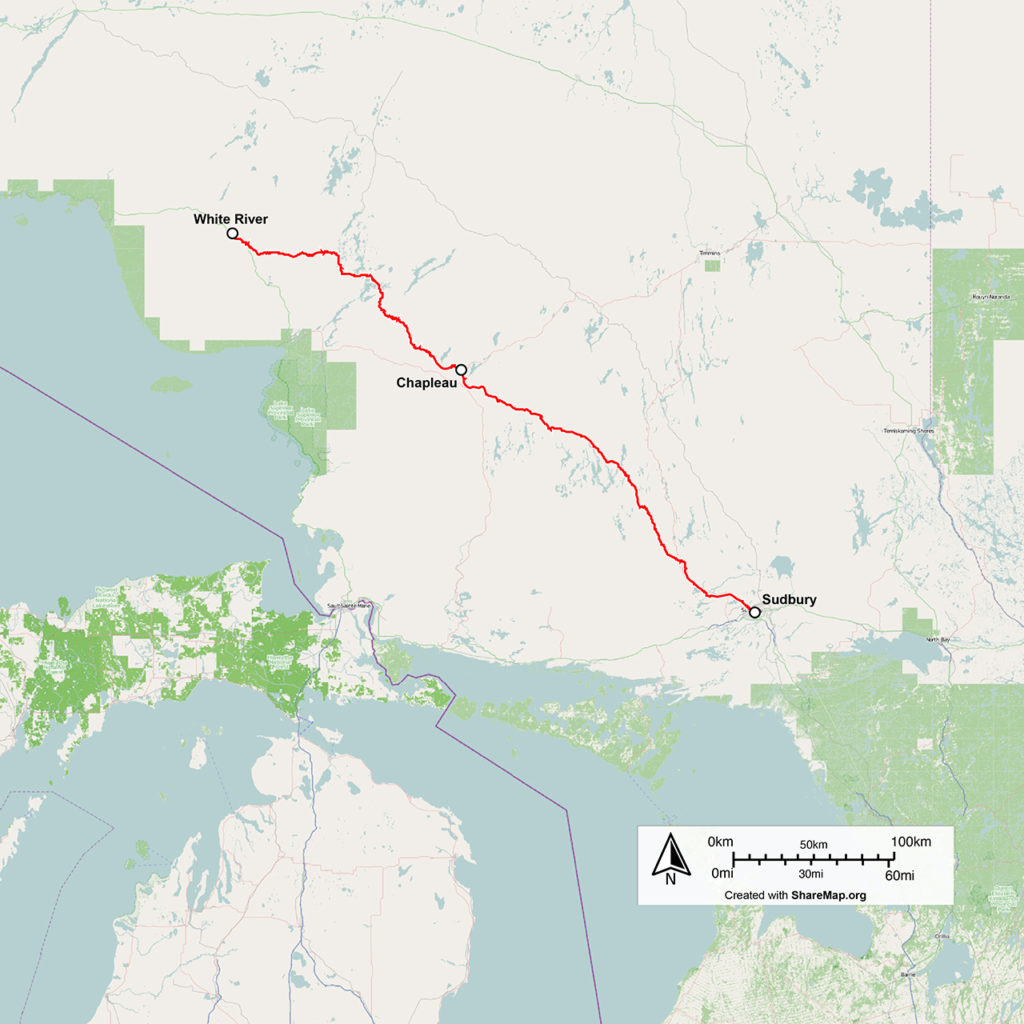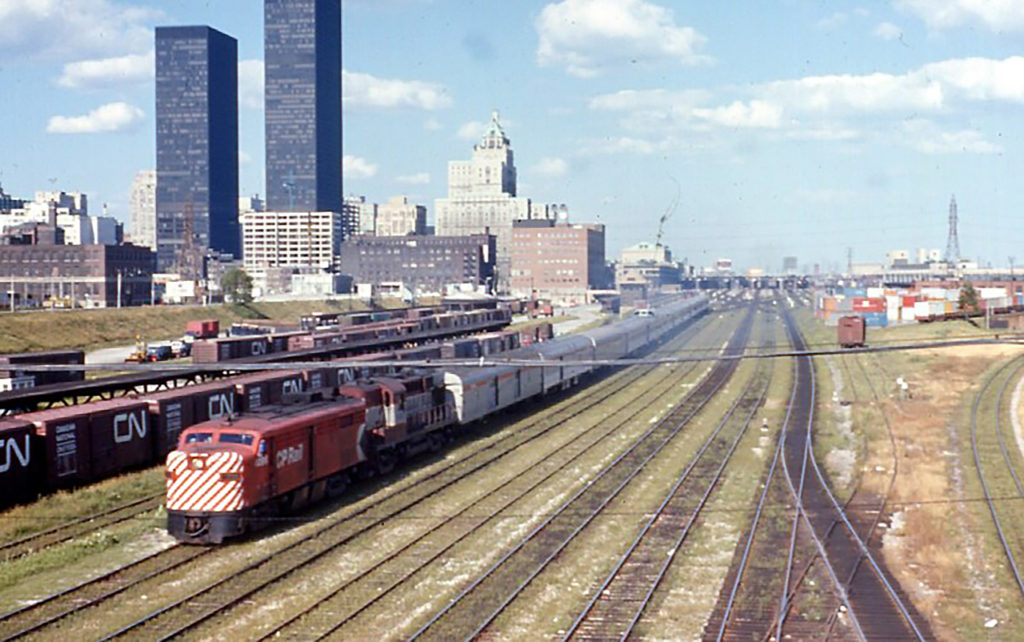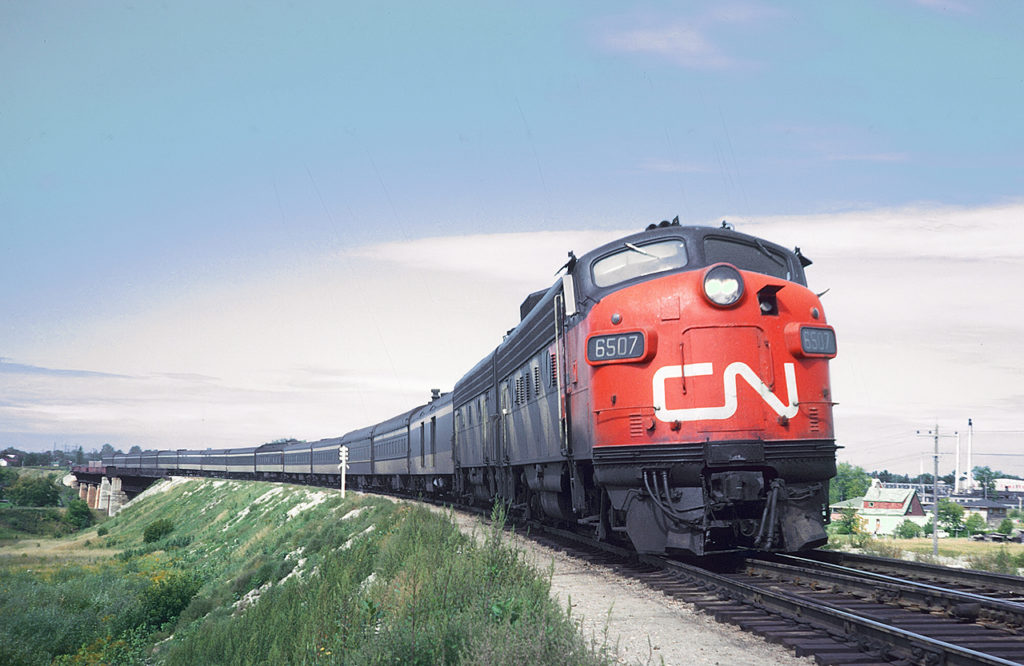
Adventures on VIA Rail: The Last ‘Budd Train’
Written by David Peter Alan, Contributing Editor
KReiss/Wikimedia Commons
Fourth in a Series: There was something special about the Rail Diesel Cars (RDCs) built by the Budd Company in the middle of the past century. They were self-contained passenger cars (and some baggage cars, too) that ran on many railroads in Canada, the Northeastern United States and elsewhere. They had a unique “feel” as they rode, as well as an equally unique sound as the on-board diesel engines revved up, just before the train (sometimes as a single car, and sometimes coupled with other RDCs) started moving.
RDCs were used for commuter-length runs, corridor-length trips on lightly-patronized lines, and even for long trips where they replaced once-famous trains until those runs were discontinued. From the 1950s onward, they were seen and heard (yes, their engines were loud) on railroads from the Boston & Maine to Trinity Railway Express, and from the Northwestern Pacific to the Canadian Pacific. Today there are a few in service on certain tourist railroads, and there is one scheduled route where they run three times a week in each direction, year-round.
That route hosts VIA Rail Trains 185 and 186, formerly officially named the Lake Superior, but which the people along its route affectionately remember as the “Budd Train.” It is the only train on VIA Rail that runs on historic CP track (the signs have been changed to say “CPKC”), except for a few short stretches of the transcontinental Canadian. It runs between White River and Sudbury, Ontario, on a segment of the original Canadian route, from the days when CP Rail operated the train. It is isolated from any other passenger routes, and White River is a long way from other places.
Getting There from Winnipeg
My trip to ride the Lake Superior started in Winnipeg, at a dark and dingy bus station on Sherbrook Street, on the south side of the city. At one time, there were several bus routes that called at Manitoba’s capital, most of which were operated by Greyhound Canada, which suspended service west of Ontario in 2018 and went out of business completely in 2021. The few buses from Thompson do not stop at that location, so only eight buses per week do. One is a weekly bus to Regina, Saskatchewan operated by Rider Express. The other is a daily bus to Thunder Bay, Ontario, run by Ontario Northland, the bus company affiliated with the railroad of the same name.
My bus left on Monday, Aug.14 at 12:30 PM and ran on a highway loosely parallel to the CP main that once hosted such trains as the Canadian and the Dominion. The bus stopped near several places that once had CP stations and trains, like Kenora and Fort Francis on the 11-hour trip to Thunder Bay. Kenora was the most interesting place on the route. My bus wound its way through downtown after providing an opportunity to see a bit of the Lake in the Woods, where the Minnesota border juts north, making it the northernmost place in the United States south of Alaska. The rest of the stops were not that interesting, but they included a couple of convenience stores that had decent snacks (including an “assorted sandwich”; Manitoba’s name for a smaller version on a round roll of the sandwich we call a “sub”). After a one-hour layover near Thunder Bay, it was time to change to a bus bound for Sault Ste. Marie, (“the Soo”), which stopped at White River about 6:00 on Tuesday morning on its way there.
The Northwest End of the Line
The bus was due at White River at 6:00 AM, while the train was scheduled to leave at 7:00 AM from the station located about a 20-minute walk from the bus stop. The options were to spend an extra day in Winnipeg and take a chance on being stranded for two days in White River (and probably blowing the rest of my itinerary), or playing it safe by spending 25 hours in White River. I chose the latter option, which meant all day Tuesday there. I had booked a room at the Continental Motel, where the train crew also stayed. My first stop was a doughnut shop across the road, a lightly used stretch of the Trans-Canada Highway, so the day began with coffee and an opportunity to meet the local seniors, some of whom had worked on the railroad. After that, it was time to see the town, and there was not much to see. Many businesses and all the restaurants had moved away from the town’s residential area, and over to the highway.
There were still a few businesses left in the older part of town, including a food store. The train station was there, too, but it was closed, and there was no waiting room or station agent. The White River Heritage Museum was open, though, and it provided an opportunity to learn about the town and its history. The museum also featured an exhibit about the town’s most-famous character, Winnie-the-Pooh. A veterinarian from an Army cavalry unit bought a bear cub from a trapper at the White River train station and took the bear with him when he went overseas to fight in 1914. He named the bear Winnie, for his home town, Winnipeg. Winnie ended up as a popular attraction at the London Zoo, and writer A.A. Milne bought a stuffed bear modeled after Winnie for his son Christopher Robin Milne. The rest is literary history. The town also has a Winnie-the-Pooh Park, a restaurant affiliated with the Continental Motel, and a lunch truck that sold decent fish and chips. All in all, there was not much to do in White River. The town takes pride in being the coldest place in Ontario, too, but not in August.
Riding the “Budd Train”

Several passengers who were riding the train stayed at the motel, and the owner provided a ride to the station for the crew, returned to the motel, and took us passengers to the station in time for the 7:00 AM departure. The train itself consisted of three cars: one each from the classes RDC-1, RDC-2, and RDC-4. The latter was a full baggage car. Tthe RDC-1 was a standard coach of its type with a 90-passenger capacity. The RDC-2 was a combine with a capacity of 70 passengers and a baggage compartment. It pulled up to the station, and about 20 riders got on. The interior sported a 1970s style, complete with an array of pastel colors. Curtis, who oversaw the train, had coffee available for us and a few snacks, although the lack of food was not as serious a problem on that train as it had been on those that took several days to complete their trips. There would be more to eat later, in Sudbury.
The route included two intermediate station stops where the old Canadian on CP Rail used to call: Chapleau and Cartier, in addition to the final stop at Sudbury. The entire trip took somewhat more than eight hours. As with other trains on VIA Rail, there were several stops at remote settlements. Even if there were no passengers getting on or off, the baggage man delivered and picked up items from or for the baggage car at few of those places. Within that car were several storage bins, stacked on top of each other and aligned in rows. They were marked, and it was clear who the recipients were. While the flag stops at remote places were also a feature of the other VIA Rail “Adventure” routes, the unique sound, smell and feel of the old Budd cars created a sense of nostalgia that pervaded the trip.
The scenery was similar to that on the current Canadian east of Winnipeg: lakes and woods, and more of the same. Yet the sound of the RDC cars and the feel of the way they speed up or slow down is unique, and it is not available anywhere else in North America on a scheduled train. Some of the riders were railfans who had also come a long distance to ride the train.
Shortly after 3:00, the train pulled into Sudbury, where it terminated. Riders got off and on along the way, but the number who alighted at Sudbury was approximately the number who had initially boarded at White River. The Sudbury station is one of the few truly historic buildings in town, but it has not been restored to its original glory. At one time, it was a major stop for the CP transcontinental trains, the place where the Toronto section joined or split from the Montreal section, depending on the direction. The Montreal section stopped at Ottawa, too. Those days are long gone, and today the Sudbury station stands as a rundown shadow of its former self. At least it still hosts a passenger train.

A Good Railroad Museum
Sudbury is a small city that once boasted a lot of railroad activity. There are CPKC through freights, and the VIA Rail “Budd Train” still goes to White River or arrives from there, the last vestige of the old CP Rail Canadian on its original route. The town itself started as a CP railroad town, and its growth was fueled by lumber, with copper and nickel mining. A “big nickel” stands on the grounds of the Science North Museum to commemorate that history. Not much more of the city’s history is visible in the downtown area. It appeared that much of it had been bulldozed or altered into oblivion. So, sadly, Sudbury’s downtown core did not have much to see, and its museums were not nearby.
Capreol is located northwest of downtown Sudbury, and was one of the towns that was absorbed into “Greater Sudbury” in 2001. Operationally, it was Sudbury’s counterpart on CN, where the Montreal and Toronto sections of the transcontinental trains like the Continental Limited and the Super Continental split or joined, depending on direction. Capreol still hosts VIA Rail’s Canadian twice a week in each direction, and it was the destination of the ticket agent who had welcomed Train 185 on Wednesday afternoon. He had to leave quickly to be on hand to open the Capreol station for Train 1.

The next morning, it took about 45 minutes to get to Capreol from downtown Sudbury on a Greater Sudbury Transit (GOVA) local bus. I had added Capreol as my Thursday stop only the prior evening, when I learned that the Northern Ontario Railway Museum would be open. The museum is located in a railroad Superintendent’s house built in 1916, also one of the few buildings that has retained its historic appearance. The house contains exhibits about local railroading, the CN main that goes through there, mining, lumbering and other aspects of Capreol’s history and culture. The railroad collection, located behind the house, includes a CN Mountain class steam locomotive, a boxcar that had been converted into a small house for a railroad worker and his wife during the 1930s, and other equipment and tools. Probably the most interesting car in the collection is a “school car” that served remote towns along the line. It contained a classroom, a small library and living quarters for the teacher and his wife. He taught all grades, from first grade to a few basic college-level courses to the children in the towns on his circuit, as well as adult education in the evening.
Capreol’s other museum, the Heritage Centre, is located one block away, in a now-retired firehouse. It contains a fire engine and other firefighting memorabilia, more artifacts that tell the history of the town, and a large model railroad layout downstairs. It took about three hours to see both museums, and slightly more than another hour to take a quick walk around town and have lunch at the eatery where the locals go. From there, the director of the museum, with whom I also had lunch, gave me a ride to the Sudbury station for Ontario Northland buses. It is not located near downtown Sudbury, but it hosted one departure a day toward Ottawa, my next destination. The ride was not as scenic or interesting as the one from Winnipeg to White River, but it was not as long, either. The bus left about 2:45 and arrived at the VIA Rail station in Ottawa on schedule, at 10:30 PM.
Canada’s Capital
I have already reported on the transit I rode in Canada, so I will concentrate on my destination cities in this article. Ottawa’s new Confederation Line light rail took me to within walking distance of my accommodation for the night. The next day I rode the entire line by daylight, ending up back at the train station for my trip to Montreal.
In the meantime, I took a look at the city, focusing on downtown Ottawa. Like many cities, it has historic buildings interspersed with newer, less-interesting structures. There are some famous places to see: the Byward Market, the Chateau Laurier Hotel, and the bridge over the Rideau Canal (which is a popular spot for ice skating in the winter). It was not possible to see the Parliament buildings because of construction. They were not even fully in use, since the Senate was temporarily using the historic Union Station building (the current station is several miles away but is served by the Confederation Line). Because there were no tours of the Parliament buildings available, I saw the Supreme Court Building instead. Ottawa does not have a particularly strong food scene, although shwarama, the Arab counterpart to the Greek gyro, is a popular favorite.
There is more to see in Ottawa, including museums, but they will have to wait for another visit to the city. Service on VIA Rail is not one of the city’s great attractions. There is relatively frequent service to and from Toronto and fewer trains to and from Montreal, but there are no other lines that serve the capital city. There were trains directly from New York City on the New York Central at one time, but that was before most of us were born.
The last train left for Montreal at 5:50 PM, and I was on it. It was one of the first trips from Ottawa that ran with the new Siemens Venture cars instead of VIA Rail’s old corridor fleet. I did not find the comfortable. They were fixed and did not recline at all, there were no footrests, they were narrow (or at least they felt that way), there was not much leg room, and half of the seats faced backwards. In short, they were similar to the equipment that Brightline runs in Florida and Amtrak has introduced on its Midwest routes centered on Chicago. The train was packed, and I boarded early enough to get a forward-facing window seat, but the trip had the comfort level of a “commuter” train. It took slightly more than two hours to get to Montreal; about the length of the Long Island Rail Road’s East End trips, NJ Transit’s longest journeys, and many of the longer trips in the Los Angeles area on Metrolink.
I spent the next day (Friday) in Montreal, riding local transit and sampling local foods, as I reported previously. I had to be home in New Jersey for a while to attend to civic matters and catch up on writing for Railway Age. Amtrak’s Adirondack had been suspended for the summer, so I had no choice but to take a bus. New York Trailways ran an overnight bus, so I got home on Saturday morning, Aug. 19. It could have been worse. One of the few routes that Greyhound still operates to Canada is the route between Montreal and New York, so there is still a choice of buses between those endpoints.
I still had more places to go in Canada, including plans to ride the two remaining VIA Rail lines in Quebec, and the Ocean to and from Halifax, Nova Scotia. That trip would take place at the end of August and the beginning of September. I will report on the trains that serve the remote areas of northern Quebec in the next article in this series. In the meantime, I will have a feature on the “Budd cars” and their influence on passenger railroading during their heyday more than a half-century ago.

David Peter Alan is one of America’s most experienced transit users and advocates, having ridden every rail transit line in the U.S., and most Canadian systems. He has also ridden the entire Amtrak and VIA Rail network. His advocacy on the national scene focuses on the Rail Users’ Network (RUN), where he has been a Board member since 2005. Locally in New Jersey, he served as Chair of the Lackawanna Coalition for 21 years, and remains a member. He is also Chair of NJ Transit’s Senior Citizens and Disabled Residents Transportation Advisory Committee (SCDRTAC). When not writing or traveling, he practices law in the fields of Intellectual Property (Patents, Trademarks and Copyright) and business law. Opinions expressed here are his own.



